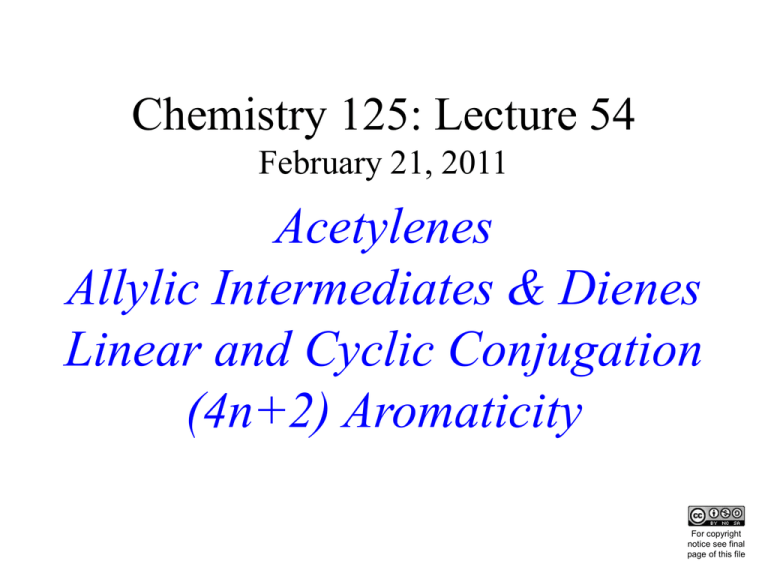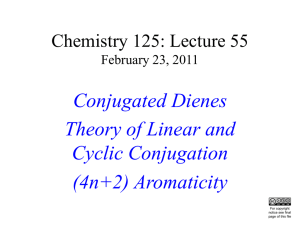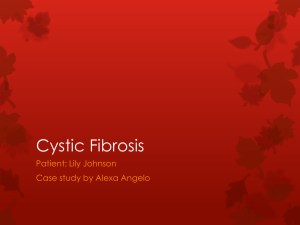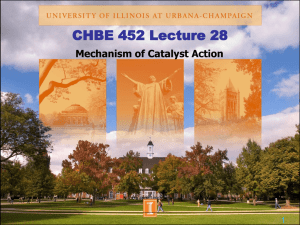
Chemistry 125: Lecture 54
February 21, 2011
Acetylenes
Allylic Intermediates & Dienes
Linear and Cyclic Conjugation
(4n+2) Aromaticity
This
For copyright
notice see final
page of this file
Generalization to
Acetylenes
Addition of HBr
Stepwise / Markovnikov
Addition of H2O
“Keto-Enol Tautomerism”
Regioselection
Addition of H2
Stepwise / Stereoselection
Acidity and base-catalyzed isomerization
e.g. J&F Sec. 10.6-10.11 pp. 444-455
Stepwise Addition of HBr to Alkyne
FeBr3
1-Hexyne + HBr
15°C
with “inhibitor”
to trap radicals
2-Bromo-1-hexene
isolated in 40% yield
100 to 1000x slower than comparable ionic addition to alkene,
because vinyl cation is not so great.
Gas Phase Ionization
CH3-CH2-Cl
CH2=CH-Cl
193 kcal/mole
CH3-CH2+ + Cl-
225 kcal/mole
CH2=CH+ + Cl-
Stepwise Addition of HBr to Alkyne
FeBr3
1-Hexyne + HBr
15°C
with “inhibitor”
to trap radicals
2-Bromo-1-hexene
isolated in 40% yield
2,2-Dibromohexane
HBr can add again to the bromoalkene (obviously
more slowly) to give a second Markovnikov addition
If the bromo substituent slows addition to an alkene,
why is there Markovnikov orientation?
Br is a “schizophrenic” substituent:
both electron withdrawing (), and electron-donating ().
Hydration and
Hydrogenation
of Alkynes
HC
CR
Hg(OAc)2
H+ / H22O
O
HgOAc
+
HC
CR
-H
H+
“Keto-Enol Tautomerism”
HgOAc
R
H
H C C+
+
H
O H
Markovnikov Enol
NaBH4
HKetoneR
C C
an easy
allylic
rearrangement
H
O H
(favors ketone
Cf. Lecture 37)
Ketone
"Enol"
ve Bond Energies
O
O
C
H
C
C
H
H
H
H H
H H
H
C
C
C
H
H
H
C=O 179
C-O
86
Bonds that change C-C 83
C=C 146
(the others should cancel
in taking the difference)
C-H
99
O-H 111
sum 361
sum 343
Can one sum bond
energies
to get
-(3/4)
18
-13.5
Kcalc = 10
= 10
accurate"Heats of Atomization"?
Kobs = 10-7 = 10-(3/4) 9.3
Ketone
Why is Enol
9 kcal/mole
"Too" Stable?
C(sp2)-H
stronger than
C(sp3)-H
(they shouldn’t actually cancel)
"Enol"
••
O
O
C
H
C
C
H
H
H
H H
H H
H
C
C
C
H
H
H
C=O 179
C-O
86
C-C
83
C=C 146
+O H
"Resonance
C-H
99
O-H 111
Stabilization”
sum 361
sum C 343
from
H
H
C 10-13.5C
Intramolecular
Kcalc = 10-(3/4) 18 =
HOMO-LUMO -7 H -(3/4)
Kobs = 10 = 10 H 9.3 H
Mixing
HC
CR
HgOAc
Hg(OAc)2
+
HC
H + / H 2O
CR
-H+
H2O
R
H
H C C+
H
O
Markovnikov Enol
Hydration with
Either Regiospecificity
HC
CR
R’2B
R’2B-H
H
e.g.
“disiamylborane”
BH3 + 2
(what is R’?)
H
C
C
R
vinylborane
Ketone
HO
HOOH
HO-
C
H
H
C H
R
Anti-Markovnikov Enol
(hindered R’2BH
adds only once)
Aldehyde
R-C
H2
C-R
C
Lindlar Catalyst
( Pd / CaCO3 / Pb )
deactivate Pd to stop at alkene
Hydrogenation with
Either Stereospecificity
n-Pr-C C-n-Pr
Na / NH3
H
H
C
R
R
syn addition
97% for
R = (CH2)3CO2CH3
n-Pr
H
C C
H
n-Pr
anti addition
80-90%
“dissolving metal reduction”
Na
NH3
e-(NH3)n + Na+
solvated electron
First
e
R-C C-R
NH2
First
H+
H
e-
R-C C-R
NH2
H
R-C C-R
R
H
C C
R
C C
R
Vinyl radicals are sp2
but they invert easily
R
Second
Vinyl anions are sp2
and invert very slowly
H
R
C C
(remember XH3)
R
Second
e-
H+
H
H
R
R
H
anti addition
H
NH2
R
H
C C
C C
R
e
NH2
(because of radical isomerism)
C C
R
Vinyl radicals are sp2
but they invert easily
R
Alkyne Acidity
and Isomerization
e.g. J&F Sec. 12.4 pp. 516-518
Approximate “pKa” Values
50
CH3-CH2CH2CH2H ~ 52
pKa *
40
CH3-C C-CH2H
CH3-CH=C=CHH
(best E-match C-H)
sp2 C_ (no overlap)
:
CH3-CH2CH=CHH ~ 44
_
sp3 C
_
(allylic)
C HOMO - overlap
(better E-match N-H)
~ 34 H2NH
~ 38
30
CH3-CH2C CH : ~ 25
sp C_ (no overlap)
20
= 16 HOH
(bad E-match O-H)
10
(e.g. J&F Acidity of 1-Alkynes Secs. 3.14 p. 129; 12.4 p. 516-518)
CH3-CH=C=CH
CH3-C C-CH2
50
H+(aq) +
k 1013 10-38 /sec
kcal/mol
40
30
20
t1/2 = 0.69/k 1025 sec = 1017 yrs
104 time since Big Bang
Equilibrium
& Rate
CH3-CH2C C
pKa 38
pKa 25
Ka 10-38
Ka 10-25
G 4/3 25 = 33
G 4/3 38 = 51
10
4.8
4.1
0
[0]
CH3-C C-CH3
-10
CH3-CH=C=CH2
CH3-CH2C CH
0.1%
0.03%
at equilibrium
CH3-C C-CH2
50
H+(aq) +
40
+ HOfavors dissn. by 21 kcal
CH3-CH=C=CH
Equilibrium
& Rate
CH3-CH2C C
kcal/mol
(4/3 16)
30
+
H
N
2
20 t1/2 30 yrs @ 300K
favors dissn. by 45 kcal
2 min @ 150°C
(4/3 34)
10
0
CH3-CH=C=CH2
CH3-C C-CH3
-10
0.0001%
at equilibrium
CH3-CH2C CH
-7.2
Trick to obtain terminal acetylene:
_
Equilibrate with RNH base
(in RNH2 solvent at room temp)
to form terminal anion.
“Quench” by adding water which
+
donates H to terminal anion and
_
_
to RNH , leaving OH , which is
too weak to allow equilibration.
Or add
H +,
_
so even [OH ] is very low.
Conjugation & Aromaticity
Conjugated Pi Systems
C
C
C
O
Yoke
Jungere
Jugóm
(to Join)
e.g. J&F Ch. 12-13
The Localized Orbital Picture
(Pairwise MOs and Isolated AOs)
Is Our Intermediate between
H-like AOs and Computer MOs
When must we think more deeply?
When does conjugation
make a difference?
Experimental Evidence
Allylic Stabilization:
Cation
Anion
R-Cl R+ + Cl(gas phase
Cl
Radical
Bond Dissociation
Energy (kcal/mol)
pKa
kcal/mol)
193
OH
16
H
101
H
89
4/3 6 = 8 kcal
Cl
Cl
172
171
as good as
secondary
OH
O
OH
10
5
Conjugation
worth
~ 13 kcal !
Allylic Cation Intermediates:
Addition of HX to Butadiene
Reason for
Kinetic
Distribution?
H
+
Br
+
HBr
-78°C
FeBr
Br- 3
H
Kinetic
vs.
Thermodynamic
Control
-78°C
H 80% 15%
Br
+
H
H 20% 85%
e.g. J&F Sec. 12.9-12.10 pp. 534-541
Butadiene
H+
Propenyl Cation
-21.4
best
potential best
overlap
LUMO+1
HOMO-1
HOMO
LUMO
+17.6
best overlap
hyperconjugated C-H
HOMO-4
LUMO+1
HOMO
LUMO
best product
Propenyl Cation
+132
best
+152
potential
+144 +99
best
potential
Surface Potential
D
Cl
p. 1288
Cl-
symmetrical
(but for D)
3.1 : 1
-78°
25°
1.6 : 1
rapid ion-pair collapse
competes with motion
e.g. J&F Sec. 12.11a,b pp. 541-543
Allylic Transition States:
SN1
krel for solvolysis in 1:1 EtOH/H2O at 45°C
Cl
Cl
<< 0.01
Cl
[100]
0.01
Cl
Cl
Cl
0.05
43
6300
+
Cl
0.07
+
Cl
39
methylation is effective
where charge is (C1,C3)
e.g. J&F Sec. 12.11a,b pp. 541-543
Allylic Transition States:
SN2
krel for Displacement by EtO- in EtOH at 45°C
Cl
[1]
Cl
1.9
Cl
Cl
37
97
560
Cl
33
Cl
Allylic Anion Intermediates:
RH Acidity
H
CH2
pKa ~52
4/3 x 9 ≈ 11 kcal/mole
H
allylic
CH2
pKa 43
4/3 x 12 ≈ 16 kcal/mole
benzylic
H
pKa 41
CH2
e.g. J&F Sec. 12.11d pp. 543-544 and Sec. 13.12
Allylic Free-Radical Intermediates:
Allylic Bromination
O
Et2O
30 min.
hn
N Br
O
N-Bromosuccinimide
(NBS)
58% yield
K. Ziegler (1942)
Cf. J&F Sec. 11.8 pp. 497-500, Sec. 12.11c p. 543
Ionic Preparation and Destruction of NBS
O
O
N H
NaOH
N-
O
Br2
N Br + NaBr
0°C
O
O
O
pKa 9.5
undo with HBr
“enol” to “ketone”
OH
N
O
+ Br2
OH
+
N Br
O
+
OH
N Br
O
Br-Br
Allylic Reactivity - Radical
Addition
2
Rate [Br2]2
+ Br2
Substitution
H
H
Br+
CH2Cl2
25°C Dark
Br
Br
+ Br-Br-BrBr2 helps Br- leave from
“Br+” in nonpolar solvent
(like protonation of OH)
initiator
(hn, peroxide, etc.)
Br•
slow
(selective)
O
Cl• also attacks
this CH2 groupN Br
H
+ HBr
Br
Br2
+ Br
H
O
Br
N H
or
How to control
O
O
Addn. vs. Subst.?
Whenever a Br2 molecule is consumed,
Keep dark
one new Br2 molecule is created.
or minimize [Br2] (tedious
to impossible?)
Automatically
maintains minimal [Br2].
H
Diene Stabilization:
Hcombustion
768.9 ±0.3
761.6 ±0.2
Conjugation
worth
~7 kcal
Hformation
17.7
25.4
Conjugation
worth
~8 kcal
Hhydrogenation
(kcal/mole)
-30.2
-29.8
-30.0
-60.0
-60.4
-56.5
Conjugation worth
~ 4 kcal/mole
End of Lecture 54
February 21, 2011
Copyright © J. M. McBride 2011. Some rights reserved. Except for cited third-party materials, and those used by visiting
speakers, all content is licensed under a Creative Commons License (Attribution-NonCommercial-ShareAlike 3.0).
Use of this content constitutes your acceptance of the noted license and the terms and conditions of use.
Materials from Wikimedia Commons are denoted by the symbol
.
Third party materials may be subject to additional intellectual property notices, information, or restrictions.
The following attribution may be used when reusing material that is not identified as third-party content:
J. M. McBride, Chem 125. License: Creative Commons BY-NC-SA 3.0







